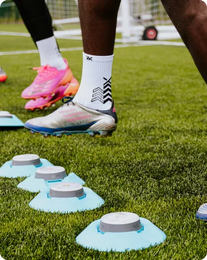
The vertical jump test is an agility test for measuring an athlete's leg strength and lower body power. It is a vertical jump testing method to check how someone holds up compared to the average human jump height. The test is widely used to evaluate participants for obstacle-course racing, police and fire departments, and general physical fitness.
Also known as the high jump test and Sargent Jump Test, the history of this test dates back to at least 100 years. It is considered one of the most authentic vertical jump measures. Besides authenticity, it is easy to conduct and doesn't require lots of equipment to administer.
What is the Test Used For?
The main goal of the high jump test is to determine the leg power of an athlete and assess their anaerobic capacity. There are two types of the vertical jump test:
- Standing vertical jump test
- Running vertical jump test
The former is done by quickly crouching and launching into the air, whereas the latter consists of a run-up before the jump. We'll be focusing on the standing vertical jump test in this article.
The Procedure of the Test
Pre-test Steps
Before proceeding with the high jump test, some pre-test steps need to be done:
- Inform the participant of the test procedure.
- Obtain their consent.
- Check for possible health risks.
- Get essential details about the participant, such as their weight, height, and age.
- Prepare the necessary test equipment.
Equipment for the Test
Here's the vertical jump test equipment needed to conduct the test:
- A wall
- A measuring tape
- A ladder
- A piece of chalk
- A notepad
Test Steps - How to Measure Vertical Jump
Here are the steps involved in the vertical jump test protocol:
- Conduct an appropriate warm-up of 10 minutes.
- Chalk the participant's fingertips.
- Ask them to stand beside the wall with flat feet and touch their chalked finger to the wall as far as it can reach statically.
- Record the height of the static marking.
- Ask the participant to leap into the air as high as possible and mark the wall again.
- Use the ladder to accurately record their maximum vertical jumping distance.
- Repeat the process three times to determine the average of the maximum distances achieved by the participant in three attempts.
The average calculated in the last step serves as a primary measure for a participant's vertical jump capabilities.
How Are the Scores Calculated?
The score is the average of the three distances (between the static and jump markings) reached by the participant. In some cases, the best of three may also be considered. The specific details of the scores are provided by the conducting authority.
Here's a scoring table that contains the vertical jump test norms to help you know what counts as a good jump. You can compare the score of your participants with the following table, ranging from excellent to unsatisfactory.
|
Males |
Females |
|
|
Excellent |
More than 28 in/ 70 cm |
More than 24 in/ 60 cm |
|
Great |
24-28 in/ 61-70 cm |
20-24 in/ 51-60 cm |
|
Above Average |
20-24 in/ 51-60 cm |
16-20 in/ 41-50 cm |
|
Average |
16-20 in/ 41-50 cm |
12-16 in/ 31-40 cm |
|
Unsatisfactory |
12-16 in/ 31-40 cm |
8-12 in/ 21-30 cm |
|
Poor |
8-12 in, 21-30 cm |
4-8 in, 11-20 cm |
The table gives you a good understanding of how high the average person can jump while also differentiating the scoring performance of male and female adults.
Variations of Vertical Jump Test
Using a vertical jump tester, commonly referred to as a Vertec device, is another way to conduct the same test. Another common approach is bending the knees before the jump. Moreover, instead of standing before the leap, some places require the participant to squat and launch into the air.
Other variations include extending one hand as high as possible and placing the other on the hip. All these variations indicate that body movement and limb placement affect how high one jumps.
How to Ace the Plyo Box Vertical Jump Test?
Any prior experience with leg plyometrics can improve the performance of participants in the vertical jump test to a great extent.
If a participant is not used to these movements, taking the test can lead to injuries. The test isn't recommended for beginners as it requires the participant to have a fit physical shape beforehand.
Preparing for the Test
As with most physical tests and plyometrics, participants can practice improving their skills and physical capabilities.
There are various drills and exercises that can improve their explosiveness to help them ace the vertical jump test. Participants can practice for the test both at home and outdoors to increase their muscle strength.
Making sure the environment is spacious and has a smooth landing surface like grass is paramount. In the case of indoor exercising, a jump mat will ensure a safe landing, allowing practice for the test without getting injured.
Engaging in drills and plyometric workouts can help athletes train their muscle fibers to produce the maximum amount of force in a short amount of time. Before taking the vertical jump test, participants are advised to prepare for it in the prior months.
Training Drills for Vertical Jump Test Using BlazePods
Performing various drills by incorporating Blazepods to train for the test faster and more efficiently leads to significantly better results. With Blazepods, athletes can streamline their exercise patterns and improve their high jump scores. This is due to Blazepods unique features to:
- Accurately measure acceleration in varying directions
- Time their stop and go instances
- Produce live, digitized analysis of your performance
- Monitor and highlight aspects where improvement is needed
- Perform comparisons with previous achievements
- Set attainable benchmarks to track progress
These are just a handful of ways Blazepods can boost the training progress for the high jump test.
Here are some drills and exercises that athletes can perform using Blazepods to improve their jumping abilities and ace the test. Coaches may also modify these drills.
Lateral Skater Jumps
Lateral Skater Jumps is an explosive version of side lunges. They improve balance, lower body strength, and coordination.
Drill Execution
- Stand on your left leg.
- Lower your hips by bending your left knee.
- Jump explosively off to the right side and land on your right leg.
- Try to jump as far as possible.
- Bring your left leg towards your right ankle while keeping it in the air.
- Repeat the process by jumping from side to side.
- As soon as you land, jump to the other side.
To make the drill more challenging, tap a Blazepod placed on the floor with your hand every rep.
The Blazepods will help measure your speed and number of reps. Your aim should be to decrease your contact time with the ground.
Single Leg Bounds
This is another plyometric workout to improve vertical jump test scores substantially. Your goal in this drill is to complete the repetitions as fast as you can.
Drill Execution
- Sprint with one leg while maintaining the other in the air.
- Take turns with each leg to make contact with the ground.
- Hammer your foot down each time you land.
- Bring your knee back up swiftly to recover energy.
Squat Jumps
This plyometric drill is integral to boosting lower body strength. The main aim of squat jumps is to exercise calves, hamstrings, and glutes. Squat jumps also include explosive hip expansion, which is crucial for acing the vertical jump test.
Drill Execution
- While facing a wall, space both feet about 2 feet apart.
- Place two Blazepods on the wall, where your hands would be while jumping.
- Do a regular squat and jump explosively.
- Tap the pods with both hands.
- Land back into the squatting position.
- Use Blazepods to time jumps and record the height.
To make the drill more challenging, move the Blazepods higher and higher to set improvement goals for the squat jumps.
Tuck Jumps
Tuck jumps are an advanced variation of squat jumps, helping athletes train for greater explosiveness. It is similar to a squat jump, but this time, the athlete contracts their legs such that their knees are raised to the chest to produce knee, ankle, and hip flexion.
Drill Execution
- Space both feet about 1 foot apart.
- Slightly bend the knees and reach outwards with both arms at shoulder height.
- Jump upwards and touch both knees to both hands.
- Use Blazepods to time jumps and record the height.
Depth Jumps
This drill is excellent for improving reactive strength and increasing explosiveness. Depth jumps guarantee considerable gains in vertical jump height.
Drill Execution
- Jump off a 12-inch high Plyo box onto the ground.
- Tap Blazepods placed on the floor.
- Launch into a vertical jump the very next moment.
- Expand both arms over the head while in the air.
- Land softly and tap the pods again.
In Conclusion
The high jump test is an effective technique to assess the leg muscle strength of an athlete. It is an expert-verified method of determining the lower body explosiveness and power of an athlete. Athletes can work out and engage in multiple jumping drills using Blazepod to perform better at this test, find out more about Blazepod here.
Frequently Asked Questions (FAQs)
What is the vertical jump test?
The vertical or high jump test is an effective method of estimating the leg muscle strength of an athlete. It is conducted by having the participant stand beside a marked wall and highlighting their static and jump reach on said wall. The difference between the two markings is taken, and an average of three attempts is calculated. Some testing authorities also consider the best of three instead of an average.
How high can the average person jump?
As described in the table earlier, the average vertical jump height is 16-20 inches(40-50cm) for men and 12-16 inches(30-40cm) for women.
How to improve explosiveness?
There are specific drills and plyometric techniques that can improve an athlete's explosiveness. The best drills for lower body strength include tuck jumps, depth jumps, single-leg bounds, and lateral skater jumps.
What component of fitness does the vertical jump test?
The vertical jump test mainly tests the participant's lower body strength and leg muscle power.
What is a significant vertical jump increase?
A significant vertical jump improvement depends on how long the athlete has been training. At an intermediate training level (1 to 2 years), a realistic improvement goal is 6-10 inches.
























